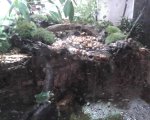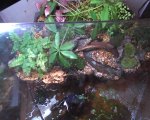rivkah
New member
- Joined
- Mar 25, 2012
- Messages
- 23
- Reaction score
- 1
- Points
- 3
- Location
- Pennsylvania
- Country
- United States
Hi,
Let me start by saying that although I am new to this site I am not new to critter keeping. I have been keeping and breeding all sort of fish for more decades than care to admit at this time. I have also kept and bred both n. viridescens and pyrrhogaster, but that was a long time ago.
About 25 years ago when, as the phrase goes "I was young, stoned and stupid" the foursome of n. viridescenes I got from my lfs accidently bred. Without knowing near enough, too many eggs hatched, too many tadpoles later, I set up a baby wading pool to house them all. Then, too many morphed, I felt forced to set up another wading pool created to minic a forest floor, complete with "creek" empting into a pond. With endless food stuff (pill bugs, spring tail, red wigglers, etc) around 150 of them matured into eastern spotted newts. I sold or gave away about 50 of them, the remainder I released into a secluded area where I had seen them previously. They are native to part of Pennslvania. It was too labor intensive for me to every want to do it again.
Fast forward.... about 8 months ago I got six red efts, who are being housed in what I call a "dry terrarium" (30 gallon tank), one without a body of water or moving water but with only small bowls of water. My questions are: How do I tell when they are ready to be set up into a more aquatic environment without setting up a semi aqatic tank? Is there a way to tell? Their tails are beginning to flaten and their color is starting to fade and is becoming orange-ish with a green-ish over cast. Previously it was easy to tell - they just spent more and more time in the creek and pond.
Next: o. pyrrhogaster: About 6 months ago I got 3 fire belly newts and set them up in a semi aquatic 35 gallon hex tank. Other than the first week, I have not seen them in the water area. I had always known fire belly newts to be almost completely aquatic. They are feed well on flightless friut flies and red wigglers, seem healthy and happy although not active, instead spending most of their days staying in small provided caves (from Even Rosethal), only venturing out to feed. The temperatures with this enclosure are between 67 to 72 depending where and when the reading is taken and humidity is around 80%. Is it normal for them to spend all their time on land? Hidden? Although I have had fire bellies before, these are acting very differently from the last ones.
Please see the enclosures of each (I am not very technological, and therefore the pictues are not in a good order). Also, I have increased the water level in the 35 hex to almost level with the land and have removed the silly turtle. These pictures were each taken with a couple days of construction. Now the plants have grown it.
Thank you
Let me start by saying that although I am new to this site I am not new to critter keeping. I have been keeping and breeding all sort of fish for more decades than care to admit at this time. I have also kept and bred both n. viridescens and pyrrhogaster, but that was a long time ago.
About 25 years ago when, as the phrase goes "I was young, stoned and stupid" the foursome of n. viridescenes I got from my lfs accidently bred. Without knowing near enough, too many eggs hatched, too many tadpoles later, I set up a baby wading pool to house them all. Then, too many morphed, I felt forced to set up another wading pool created to minic a forest floor, complete with "creek" empting into a pond. With endless food stuff (pill bugs, spring tail, red wigglers, etc) around 150 of them matured into eastern spotted newts. I sold or gave away about 50 of them, the remainder I released into a secluded area where I had seen them previously. They are native to part of Pennslvania. It was too labor intensive for me to every want to do it again.
Fast forward.... about 8 months ago I got six red efts, who are being housed in what I call a "dry terrarium" (30 gallon tank), one without a body of water or moving water but with only small bowls of water. My questions are: How do I tell when they are ready to be set up into a more aquatic environment without setting up a semi aqatic tank? Is there a way to tell? Their tails are beginning to flaten and their color is starting to fade and is becoming orange-ish with a green-ish over cast. Previously it was easy to tell - they just spent more and more time in the creek and pond.
Next: o. pyrrhogaster: About 6 months ago I got 3 fire belly newts and set them up in a semi aquatic 35 gallon hex tank. Other than the first week, I have not seen them in the water area. I had always known fire belly newts to be almost completely aquatic. They are feed well on flightless friut flies and red wigglers, seem healthy and happy although not active, instead spending most of their days staying in small provided caves (from Even Rosethal), only venturing out to feed. The temperatures with this enclosure are between 67 to 72 depending where and when the reading is taken and humidity is around 80%. Is it normal for them to spend all their time on land? Hidden? Although I have had fire bellies before, these are acting very differently from the last ones.
Please see the enclosures of each (I am not very technological, and therefore the pictues are not in a good order). Also, I have increased the water level in the 35 hex to almost level with the land and have removed the silly turtle. These pictures were each taken with a couple days of construction. Now the plants have grown it.
Thank you



